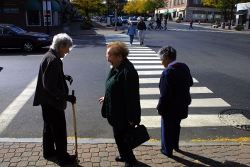Safe Streets for Seniors
New York City
Source: Pedestrian and Bicycle Information Center (PBIC)
Problem
In New York City, adults aged 65 and older make up 12 percent of the city's population, but accounted for 39 percent of its pedestrian fatalities between 2002 and 2006. Despite this grim overrepresentation, older pedestrians are underrepresented on the streets of New York City, according to a study commissioned by New York City Department of Transportation (NYC DOT). With the city's senior population expected to nearly double between 2010 and 2035, pedestrian safety among older adults had become a priority for NYC DOT.
Background
Image: Dan Burden
Improvements in bicycle infrastructure, combined with rising fuel costs, from 2000 to 2010 have resulted in unprecedented spikes in bicycle commuting, and improvements to pedestrian facilities have increased safety. But the need to tackle problems such as inadequate public spaces and insufficient amenities for pedestrians and bicyclists culminated in a commitment to create a livable community. In 2007, New York City released PlaNYC: A Greener, Greater New York, a long-range, comprehensive plan to address economic, social, and environmental concerns facing the city's five boroughs: the Bronx, Brooklyn, Manhattan, Queens, and Staten Island. NYC DOT commissioned a consultant to conduct public life surveys around the city to determine what was missing from NYC sidewalks and streets, which was later released in the report World Class Streets: Remaking New York City's Public Realm. According to the count results and surveys, several key types of public space needed improvement and only 10 percent of pedestrians observed were seniors or children, while those two age groups make up 30 percent of the city's population. In the report, the department outlined an overall approach called the World Class Streets initiative. Included under this initiative are a number of new programs and guidelines that respond directly to overall problems and individual issues on specific streets including Safe Streets for Seniors, a safety initiative for older NYC pedestrians.
Solution
In January 2008, NYC DOT and the city's Department for the Aging partnered to announce the Safe Streets for Seniors program. Using crash history, NYC DOT identified 25 focus areas where pedestrian injuries and fatalities that involved older adults were particularly high.
From these 25 neighborhoods, NYC DOT selected five pilot neighborhoods -- one in each borough -- to test the program. These sites included:
- Brighton Beach (Brooklyn)
- Fordham/University Heights (Bronx)
- Lower East Side (Manhattan)
- Flushing (Queens)
- New Dorp/Hylan Boulevard (Staten Island)
The program focuses on safety concerns for senior pedestrians, including insufficient crossing times, broken or missing curb ramps, crosswalks and street markings that are difficult to see, drainage problems at curbs and in crosswalks, and driver behavior problems such as turning vehicles that fail to yield to pedestrians.
In 2008 and 2009, NYC DOT moved quickly to assess problems in its five pilot neighborhoods, identify and implement countermeasures, and launch comprehensive educational campaigns about the Safe Streets for Seniors program and associated traffic changes. In the pilot project in Flushing, Queens, NYC DOT took a multipronged approach to address heavy pedestrian and vehicle volumes, conflicts caused by failure of the turning vehicles to yield at crosswalks, dangerous pedestrian behaviors, and long crossing distances.
In this pilot, NYC DOT added 23 new signs instructing users to "Wait for Walk," "Yield to Pedestrians in Crosswalk," and "Wait for Green Light." The department also added several pedestrian refuge islands, left-turn bays for vehicles, high-visibility crosswalks, and advance stop bars. In some cases, NYC DOT narrowed streets by reducing the number of vehicle lanes.
Other countermeasures involved installing new or upgraded pavement markings, high-visibility crosswalks, and advance stop bars to encourage drivers to stop before a crosswalk rather than in it. Maintenance activities included replacing missing roadway signs, repairing broken curb ramps, and installing needed ramps. The city also has employed other pedestrian-friendly treatments such as leading pedestrian intervals, which activate a walk signal before vehicles get a green light so pedestrians can have a head start into a crosswalk. Leading pedestrian intervals are a particular help to pedestrians who have slower walking speeds.
Results
The results from this combination of improvements were encouraging. For instance, injuries at the intersection of Northern Boulevard and Bowne Street have decreased by 45 percent since NYC DOT installed a pedestrian refuge island at that location. Pedestrian refuge islands and a road diet (reduced number of lanes with freed space converted to parking, bike lanes, landscaping, walkways, or medians) on Manhattan's Chrystie Street resulted in a 66 percent reduction in pedestrian crashes.
Having completed improvements at the pilot sites, NYC DOT is continuing progress on the Safe Streets for Seniors program. The department selected 10 of the 25 focus areas as phase I projects and the engineering studies and recommendations prepared for those areas were reviewed to determine what needed to be adjusted in each neighborhood. Studies for phase II areas began in January 2010.





